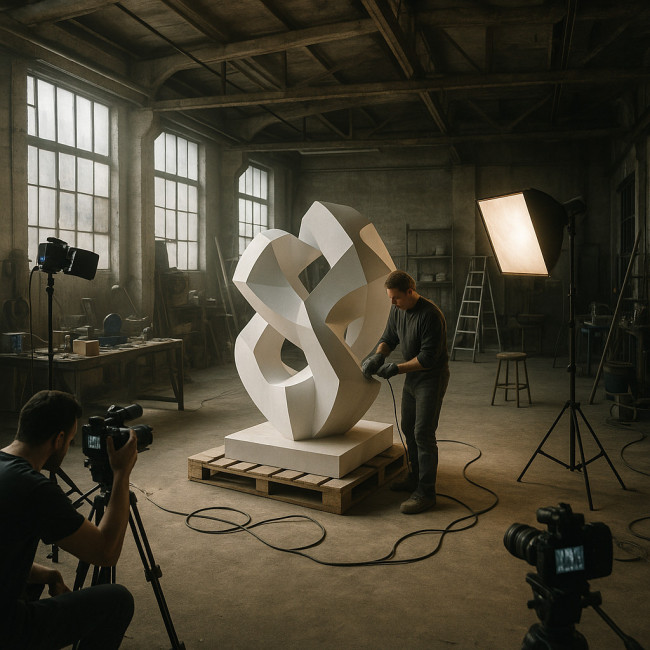Corporate art commissions: scope, milestones and long-term display rights
Commissioning artwork for headquarters, hotels or client lounges elevates brand perception, but only if the scope, milestones and display rights are crystal-clear from day one. This guide walks you through the entire lifecycle of a corporate art commission—from the first briefing to long-term ownership or licensing—so you can negotiate fair contracts, keep projects on schedule and safeguard both creative and commercial value.
Why do companies commission art?

Original art offers measurable returns: increased foot-traffic, longer dwell time, stronger employee pride and richer storytelling in brand content. Recent workplace studies show that art-filled environments raise creativity by up to 17 % and improve staff well-being scores. Specialised image designers help translate these intangible benefits into visual statements that align with corporate values.
Defining project scope: key variables
1. Artwork type and scale
- Mural or wall relief
- Sculpture or installation
- Digital or interactive piece
- Series of framed works
List each component, its dimensions and material specifications. Precise scope stops “feature creep” and keeps budget forecasts realistic.
2. Location & environmental constraints
Note ceiling load, foot-traffic, lighting, humidity and cleaning regimes. A bronze lobby sculpture demands different sealants and maintenance budgets than a textile wall hanging in a boardroom.
3. Budget structure
Typical corporate art commissions range from €15 000 for a single painting to €500 000+ for multi-site installations. Agree early on:
- Artist fee and studio overheads
- Fabrication or foundry costs
- Transport, insurance and installation
- Contingency (usually 10 %)
4. Timeline and milestones
Align creative checkpoints with corporate diary events—product launches, building inaugurations or annual general meetings.
| Milestone | Typical timing | Deliverables |
|---|---|---|
| Signed brief & deposit | Week 0 | Scope, budget, contract |
| Concept presentation | Week 3–4 | Sketches, maquette, colour tests |
| Design approval | Week 5–6 | Final render, material samples |
| Production phase | Week 7–18 | Progress images, studio visit |
| Installation | Week 19 | On-site mounting, safety checks |
| Handover & rights registration | Week 20 | Certificate of authenticity, usage licence |
Payment schedule that protects both sides
- 40 % deposit upon contract signature
- 30 % after design approval
- 20 % after production sign-off
- 10 % after successful installation
Linking staged payments to milestones motivates punctual delivery and ensures the artist's cashflow covers material purchases.
Long-term display rights: ownership, licensing and moral rights
Companies often confuse physical ownership with intellectual property. The table below clarifies the main options.
| Right | Default holder (EU) | Typical corporate clause | Risk if ignored |
|---|---|---|---|
| Copyright | Artist | Non-exclusive licence to reproduce work in marketing | Legal takedown of brochures, videos |
| Display right | Owner of object | Perpetual public display on specified premises | Removal request by artist |
| Modification right | Artist (moral right) | Written consent required for relocation or restoration | Fines, reputational damage |
| Re-sale right | Artist | Waiver or royalty share on future sale | Unexpected royalties owed |
Key questions to settle
- Can the company photograph the work for annual reports?
- May the artist exhibit process images in a future retrospective?
- Who pays for conservation after 10 years?
- What happens if the building is sold or refurbished?
Contract clauses you should never skip
Draft agreements with the same care you would apply to artist-architect scope clauses. Mandatory points:
- Clear description of artwork, dimensions, materials and edition size.
- Timeline & milestones with penalties or renegotiation triggers for significant delays.
- Payment terms, late fees and currency.
- Insurance responsibilities during transit, installation and display.
- Intellectual property licence scope, territory and duration.
- Maintenance plan and annual budget.
- De-installation or relocation procedure to obtain artist consent and cover costs.
- Termination clause in case of force majeure or stakeholder change.
Practical tips for a smooth production phase
- Schedule a mid-production studio visit to check material quality.
- Set up shared folders for updated drawings and safety certificates.
- Assign one corporate point of contact to avoid feedback bottlenecks.
- Use protective copyright watermarks on publicity images until final payment clears.
Leveraging your commission beyond the lobby

A commissioned piece can generate content for years—behind-the-scenes videos, limited-edition merchandise or charity auction prints. For instance, the licensing strategies used in limited-edition object design easily translate to fine-art contexts.
If your brand hosts culinary showcases, study the nuances of edible art licensing to avoid similar pitfalls.
When to involve third-party stakeholders
Complex installations often require structural engineers, fire-safety officers and brand-experience consultants. Early collaboration prevents expensive retrofits later. Companies planning to sell reproductions should also consult intellectual-property lawyers or platforms that specialise in limited-edition print licensing.
[Quick self-check] Are you commission-ready?
FAQ
- Who owns the physical artwork once installed?
- Usually the corporation owns the object after final payment, but the artist retains copyright unless the contract states otherwise.
- Can we move the artwork to another building later?
- Only with written consent from the artist, as relocation can affect moral rights and may void conservation guarantees.
- Are reproduction rights automatically included?
- No. You must negotiate a separate, often non-exclusive licence for brochures, social media or advertising campaigns.
- How long should a maintenance agreement last?
- Five to ten years is common, but high-traffic or outdoor pieces may need longer commitments.
- What happens if the artist's style changes and we need updates?
- Commission a new work or negotiate an adaptation clause; the original contract can't force stylistic changes on the artist.
Next step
Ready to brief an artist? Download our editable scope template and eliminate guesswork, or browse Artfolio's vetted creators to find the perfect match.











